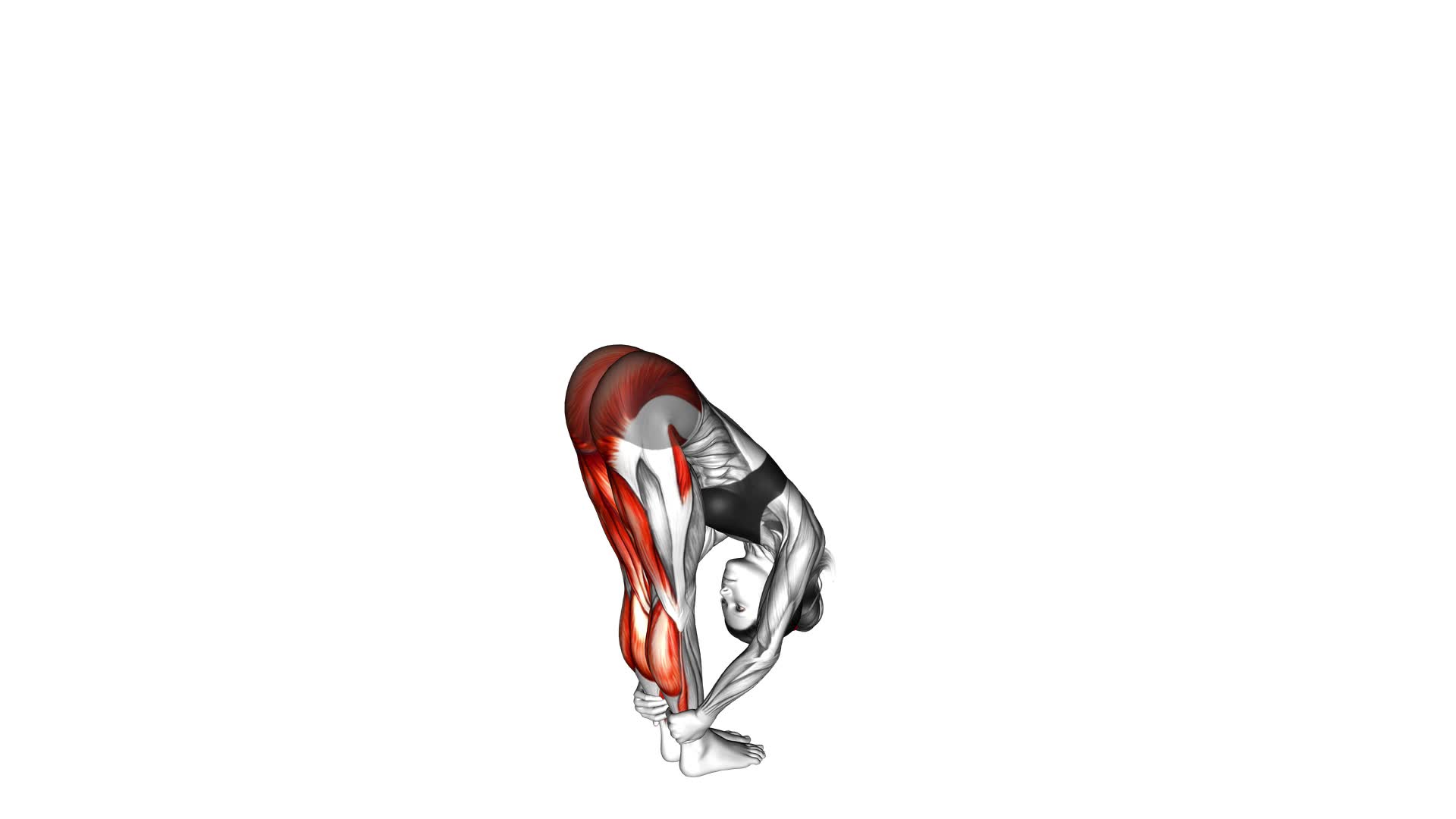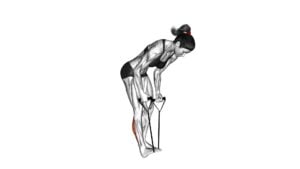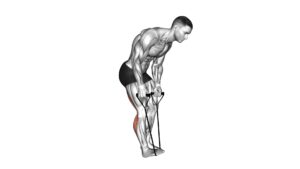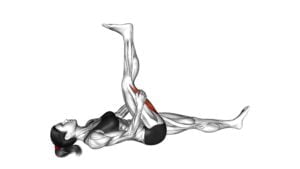Standing Hamstring Stretch (female) – Video Exercise Guide & Tips

Are you looking to improve your flexibility and prevent injury?
Watch This Exercise Video
In this video exercise guide, you'll learn a simple yet effective standing hamstring stretch.
This stretch targets the muscles in the back of your thighs, helping to increase flexibility and reduce tightness.
With step-by-step instructions and helpful tips, you'll be able to perform the stretch correctly and avoid common mistakes.
Get ready to maximize the effectiveness of your stretching routine with this informative video guide.
Key Takeaways
- The standing hamstring stretch increases flexibility and improves range of motion in muscles and joints.
- It helps prevent hamstring injuries and enhances performance in physical activities.
- Equipment needed for the exercise includes an exercise mat, towel, chair or wall for balance, and resistance band or towel for advanced variations.
- Common mistakes to avoid during the exercise include rounding shoulders, hunching the back, locking the knees, straining the neck and upper back, and putting unnecessary pressure on the lower back.
Benefits of the Standing Hamstring Stretch
To maximize the benefits of the Standing Hamstring Stretch, you should perform this exercise regularly. Flexibility is an important component of overall fitness, and this stretch specifically targets the hamstrings, which play a crucial role in various physical activities. By incorporating this stretch into your routine, you can improve your flexibility and prevent hamstring injuries.
Stretching is an effective way to increase the range of motion in your muscles and joints. When your hamstrings are tight, they can limit your ability to perform certain movements, such as bending forward or extending your leg. Regularly stretching your hamstrings can help improve their flexibility, allowing you to move more freely and with greater ease.
Additionally, stretching the hamstrings can help prevent injuries. When the hamstrings are tight, they're more prone to strains and tears, especially during activities that involve quick changes in direction or explosive movements. By regularly stretching your hamstrings, you can increase their flexibility and reduce the risk of injury.
Incorporating the Standing Hamstring Stretch into your fitness routine is a simple and effective way to improve your flexibility and prevent hamstring injuries. Remember to perform this stretch regularly and listen to your body's limits to avoid overstretching.
Equipment Needed for the Exercise
You will need 1 piece of equipment for the Standing Hamstring Stretch exercise. Here are the essential items you'll need:
- Exercise Mat: A mat provides cushioning and support for your body during the stretching exercises. It helps to prevent discomfort or strain on your joints and muscles.
- Towel: A towel can be used to enhance the stretch by providing a deeper stretch and added resistance. You can use it to wrap around your foot and gently pull it towards you, increasing the intensity of the stretch.
- Chair or Wall: Having a chair or a wall nearby can help you maintain balance and stability during the exercise. You can use the chair as a support to hold onto while performing the stretch, or the wall to lean against for added stability.
Having these equipment will ensure that you can perform the Standing Hamstring Stretch exercise safely and effectively.
Now that you have everything you need, let's move on to the next section for the step-by-step instructions on how to properly perform the stretch.
Step-By-Step Instructions for Performing the Stretch
To perform the Standing Hamstring Stretch exercise, follow these step-by-step instructions.
- Begin by standing up straight with your feet hip-width apart.
- Take a step forward with your right foot, keeping your leg straight and your toes pointing forward.
- Slowly hinge forward at the hips, reaching your hands towards your right foot.
- Keep your back straight and avoid rounding your shoulders.
- You should feel a stretch in the back of your right leg.
- Hold this position for 20 to 30 seconds, focusing on relaxing and deepening the stretch with each breath.
- Repeat on the other side by stepping forward with your left foot.
For beginner modifications, you can use a yoga block or a sturdy chair for support.
- Place the block or chair in front of you and rest your hands on it as you hinge forward.
- This will help you maintain balance and stability.
Advanced variations of the Standing Hamstring Stretch include using a resistance band or towel to increase the intensity of the stretch.
- Simply loop the band or towel around the ball of your foot and hold onto the ends with your hands.
- Gently pull the band or towel towards you as you hinge forward, deepening the stretch in your hamstrings.
Remember to always listen to your body and modify the exercise as needed to avoid any discomfort or pain.
Common Mistakes to Avoid During the Exercise
One common mistake to avoid during the Standing Hamstring Stretch exercise is allowing your shoulders to round forward. Proper form is essential for maximizing the effectiveness of the stretch and preventing injury.
Here are some common mistakes to avoid:
- Allowing your shoulders to round forward can cause strain on your neck and upper back. Keep your shoulders back and down, engaging your shoulder blades.
- Hunching your back can limit the stretch and put unnecessary pressure on your lower back. Keep your spine straight and upright throughout the exercise.
- Locking your knees can lead to hyperextension and strain on the knee joint. Keep a slight bend in your knees to protect your joints and maintain stability.
By avoiding these common mistakes, you can ensure that you're performing the Standing Hamstring Stretch with proper form and getting the most out of your workout.
Now, let's move on to the next section where we'll discuss tips for maximizing the effectiveness of the stretch.
Tips for Maximizing the Effectiveness of the Stretch
To maximize the effectiveness of the stretch, use a towel or strap to assist in reaching your toes while keeping your shoulders back and spine straight. This will help you achieve a deeper stretch and target the hamstring muscles more effectively. By using a towel or strap, you can gradually increase your flexibility over time and prevent any potential injuries.
When performing the standing hamstring stretch, it's important to maintain proper form and technique. Keep your core engaged and avoid rounding your back as you bend forward. This will ensure that the stretch is focused on the hamstrings and not on other muscles or joints.
To further maximize flexibility, try incorporating dynamic stretching exercises into your routine. These exercises involve moving your muscles and joints through a full range of motion, which can help improve flexibility and prevent injuries. Examples of dynamic stretching exercises for the hamstrings include leg swings and walking lunges.
Additionally, it's important to listen to your body and not push yourself too hard. Gradually increase the intensity and duration of the stretch over time to avoid straining your muscles. Remember to breathe deeply and relax into the stretch, allowing your muscles to release tension.
Modifications and Variations for Different Fitness Levels
Now let's explore some modifications and variations to cater to different fitness levels.
For beginners, there are modified versions of the standing hamstring stretch that provide a gentler stretch and help build flexibility gradually.
On the other hand, advanced variations can be added to challenge those who are more experienced and flexible, allowing them to deepen their stretch and target specific areas.
Beginner Modifications
If you're new to the standing hamstring stretch, there are modifications and variations available to accommodate different fitness levels. Here are some beginner modifications and alternative stretches to help you get started:
- Use a yoga block: If you find it challenging to reach the floor, place a yoga block or a sturdy object in front of you. This will provide support and allow you to maintain good form while stretching.
- Bent knee stretch: Instead of keeping your legs straight, you can try bending your knees slightly. This modification reduces the intensity of the stretch and is more suitable for beginners.
- Seated hamstring stretch: If standing is too difficult, you can perform a seated hamstring stretch. Sit on the edge of a chair with one leg extended in front of you and gently reach for your toes.
Advanced Variations
For advanced variations of the standing hamstring stretch, there are additional modifications and variations available to further challenge and accommodate different fitness levels.
To increase the difficulty of the stretch, you can use a towel or resistance band to add resistance. Simply loop the towel or band around your foot and hold onto the ends with your hands while performing the stretch. This will engage your muscles even more and provide a deeper stretch.
Additionally, you can try performing the stretch on an elevated surface, such as a step or bench, to increase the stretch intensity.
Remember to maintain proper form throughout these advanced modifications by keeping your back straight, shoulders relaxed, and engaging your core.
Frequently Asked Questions
How Often Should I Perform the Standing Hamstring Stretch?
To make the most of the standing hamstring stretch, it's important to know how often to do it. By incorporating this stretch into your daily routine, you can experience the benefits it offers.
Beginners can modify the standing hamstring stretch by using a strap or towel to assist in reaching their toes. This stretch helps to improve flexibility, increase range of motion, and prevent injuries.
Aim to perform this stretch at least 3-4 times a week for optimal results.
Is the Standing Hamstring Stretch Suitable for Pregnant Women?
During pregnancy, it's important to modify exercises to ensure the safety of both you and your baby. The standing hamstring stretch may not be suitable for pregnant women due to the risk of losing balance. However, there are alternative hamstring stretches that can be done safely.
Consult with your healthcare provider for pregnancy modifications and recommendations on exercises that will help you maintain flexibility and reduce the risk of injury.
Can I Perform the Standing Hamstring Stretch if I Have a Previous Hamstring Injury?
If you have a previous hamstring injury, it's important to exercise caution when performing the standing hamstring stretch. It may be beneficial for you to modify the stretch by using a support, such as a chair or wall, to help maintain balance and reduce strain on the injured muscle.
Always consult with a healthcare professional or physical therapist to ensure that you're performing the stretch safely and effectively.
The standing hamstring stretch can help improve flexibility and reduce muscle tightness.
How Long Should I Hold the Stretch Position for Maximum Effectiveness?
To get the maximum effectiveness from your hamstring stretch, it's important to hold the stretch position for an appropriate duration. The duration can vary depending on your fitness level and flexibility. Generally, it's recommended to hold the stretch for about 30 seconds to 1 minute.
Regular stretching not only improves flexibility but also helps prevent injuries, enhances athletic performance, and promotes better blood circulation. So, make sure to incorporate stretching into your routine for all these benefits.
Are There Any Specific Breathing Techniques I Should Use While Performing the Standing Hamstring Stretch?
When performing the standing hamstring stretch, it's important to focus on your breathing techniques. By taking deep breaths in and out, you can help relax your muscles and enhance the effectiveness of the stretch.
As for the stretch duration, it's recommended to hold the position for about 15-30 seconds. This allows your muscles to gradually lengthen and improve flexibility.
Remember to listen to your body and adjust the duration as needed for maximum effectiveness.
Conclusion
In conclusion, the standing hamstring stretch is a beneficial exercise for improving flexibility and preventing muscle tightness. By following the step-by-step instructions and avoiding common mistakes, you can effectively perform this stretch.
To maximize its effectiveness, it's important to maintain proper form and engage the targeted muscles. Additionally, modifications and variations can be made to accommodate different fitness levels.
Incorporating this stretch into your fitness routine can help enhance your overall flexibility and prevent injuries.

Author
Years ago, the spark of my life’s passion ignited in my mind the moment I stepped into the local gym for the first time. The inaugural bead of perspiration, the initial endeavor, the very first surge of endorphins, and a sense of pride that washed over me post-workout marked the beginning of my deep-seated interest in strength sports, fitness, and sports nutrition. This very curiosity blossomed rapidly into a profound fascination, propelling me to earn a Master’s degree in Physical Education from the Academy of Physical Education in Krakow, followed by a Sports Manager diploma from the Jagiellonian University. My journey of growth led me to gain more specialized qualifications, such as being a certified personal trainer with a focus on sports dietetics, a lifeguard, and an instructor for wellness and corrective gymnastics. Theoretical knowledge paired seamlessly with practical experience, reinforcing my belief that the transformation of individuals under my guidance was also a reflection of my personal growth. This belief holds true even today. Each day, I strive to push the boundaries and explore new realms. These realms gently elevate me to greater heights. The unique combination of passion for my field and the continuous quest for growth fuels my drive to break new ground.







